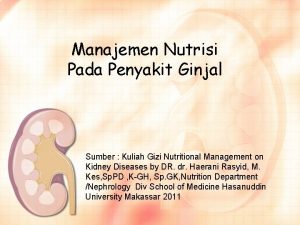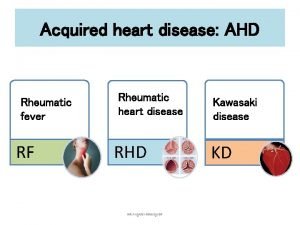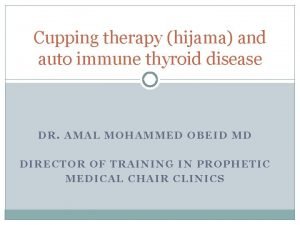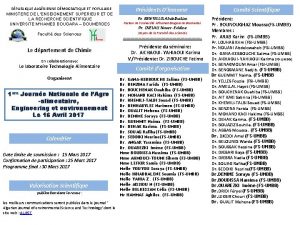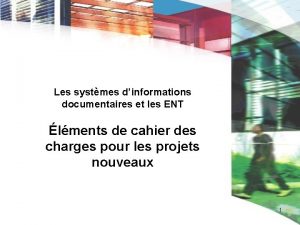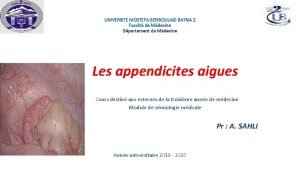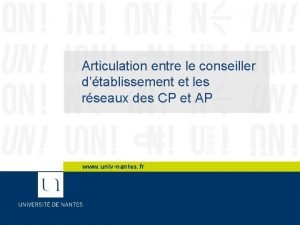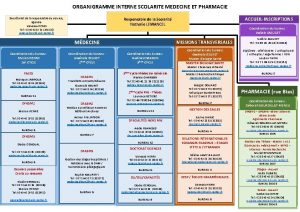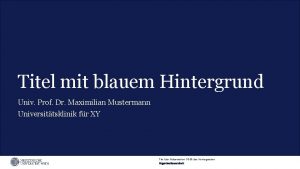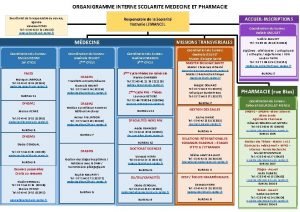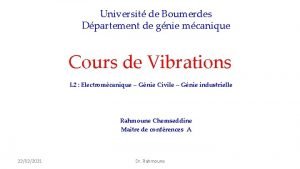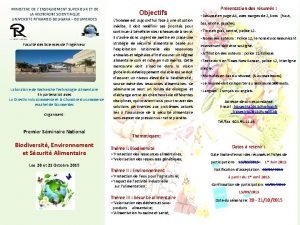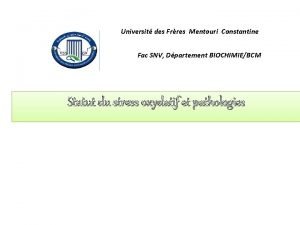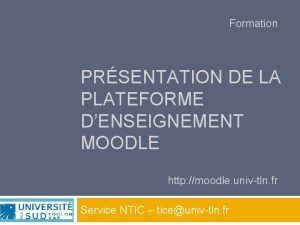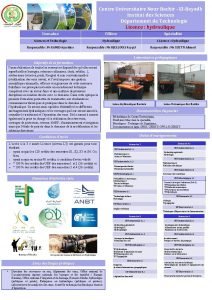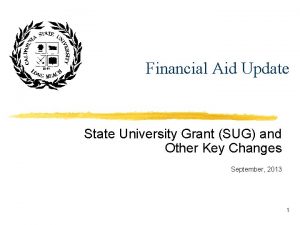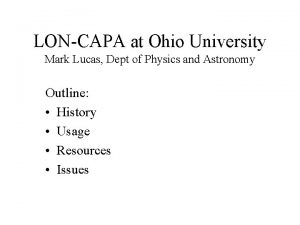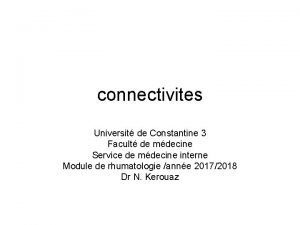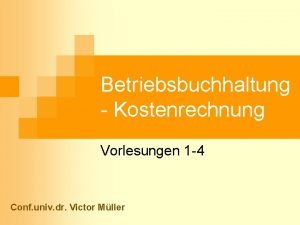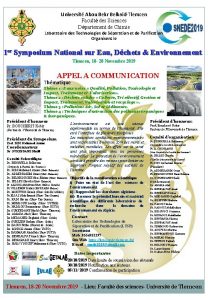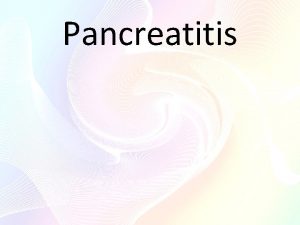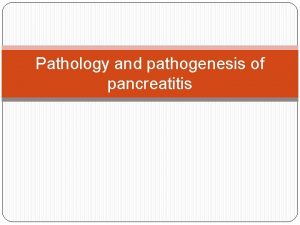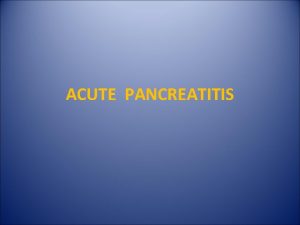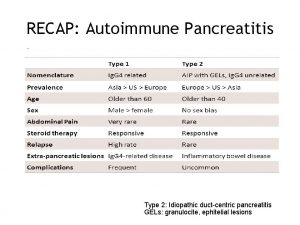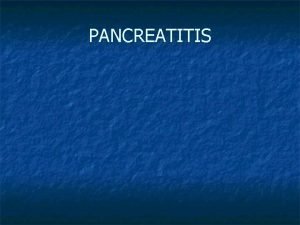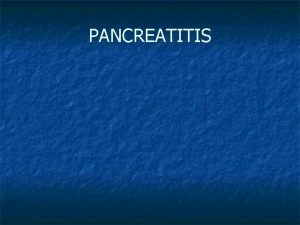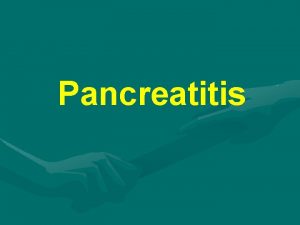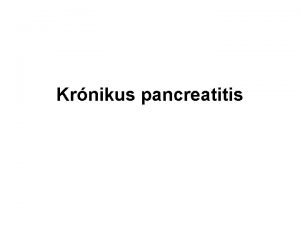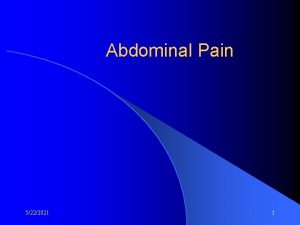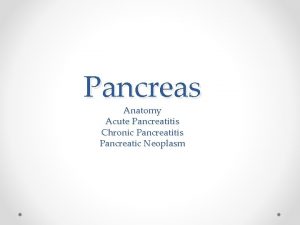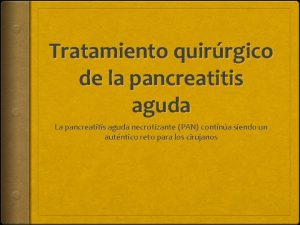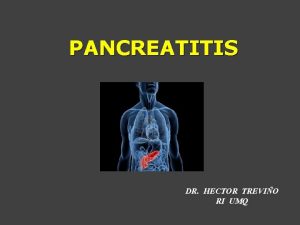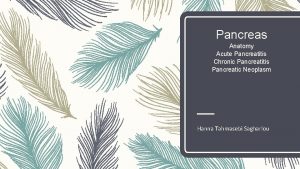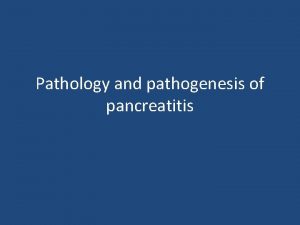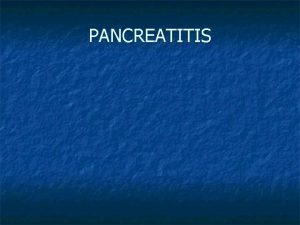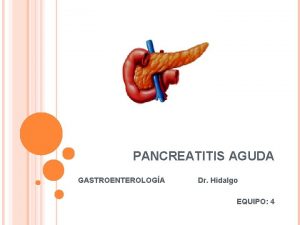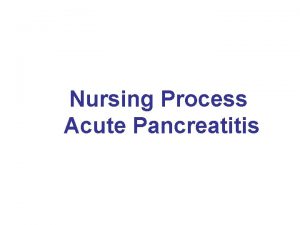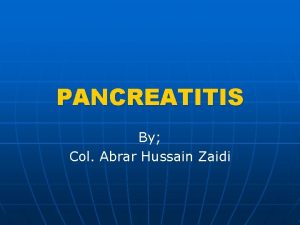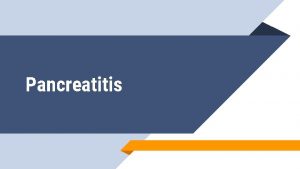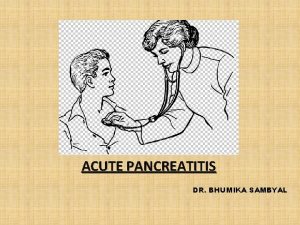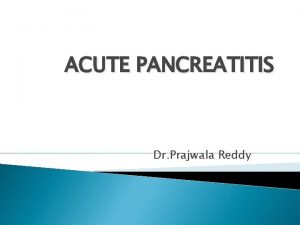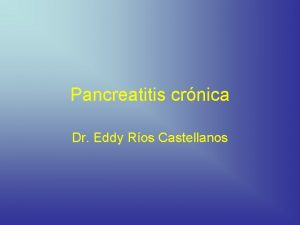Autoimmune pancreatitis Petr Dt Dept of Hepatogastroenterology Univ








































- Slides: 40

Autoimmune pancreatitis Petr Dítě Dept. of Hepatogastroenterology Univ. Hospital Brno – Czech Republic

Incidence of Chronic Pancreatitis Switzerland Poland Germany Czech Rep. Hungary Denmark Sweden Finland United States 1. 2/100 000/year 4. 0/100 000/year 7. 4/100 000/year 7. 9/100 000/year 8. 0/100 000/year 10. 0/100 000/year 23. 0/100 000/year 5. 7 -7. 6/100 000/year

Chronic pancreatitis is a progressive inflammatory disease of the pancreas with irreversible damage of pancreatic tissue exocrine and endocrine insufficiency

TIGARO Classification T I G A R O -oxic-metabolic -diopathic -enetic -utoimmune -ecurrent acute pancreatitis -bstructive Etemed, Whitcomb, 2001

AUTOIMMUNE PANCREATITIS chronic pancreatitis with distinct clinical, serological, histological and imaging features and it is involved in hyper- Ig. G 4 group of diseases.

Autoimmune pancreatitis 1961 H. Sarles Chronic inflammatory sclerosis of the pancreas (Patients with jaundice, painful crises, hyperglobulinemia, no dilatation of pancreatic duct, lymphatic infiltration) 1975 R. Waldram et al Chronic pancreatitis, sclerosing cholangitis and sicca sy in two siblings 1978 S. Nakano et al Vanishing tumor of the abdomen in patient with Sjögren´s sy 1995 K. Yoshida Concept of autoimmune pancreatitis 2001 B. Etemed, D. Whitcomb TIGARO classification

Epidemiology of autoimmune pancreatitis Japan 21/451 4, 6% Yoshida et al. Dig. Dis. Sci. 1995 Korea 17/315 5, 4% Kim et al. Am. J. Gastroenterol. 2004 Italy 23/383 6, 0% Parson et al. Pancreas 2003 4, 8% Dite et al Best Practice and Res. Czech Rep. 9/185

Sex ang age onset of autoimmune pancreatitis Nishimori I. et al. , Gastroent. , 2007

Antibodies in patients with AIP % Okazaki et al. J. Gastroent. 2001

HISORt CRITERIAS OF AIP Category A. Histology B. Imaging Criteria 1. Diagnostic (any one): a) Pancreatic histology showing periductal lymphoplasmacytic infiltrate with obliterative hlebitis (LPSP) b) Lymphoplasmacytic infiltrate with abundant (>10 cells/hpf) Ig. G 4 positive cells in the pancreas 2. Supportive (any one) a) Lymphoplasmacytic infiltrate with abundant (>10 cells/hpf) Ig. G 4 positive cells in involved extra-pancreatic organ b) Lymphoplasmacytic infiltrate with fibrosis in the pancreas Typical imaging features: 1. CT/MR: diffusely enlarged gland with delayed (rim) endhancement 2. ERCP: Diffusely irregular, attenuated main pancreatic duct Atypical Imaging Features: Pancreatitis, focal pancreatic mass, focal pancreatic duct stricture, pancreatic atrophy, pancreatic calcification C. Serology D. Other Organ involvement Elevated serum Ig. G 4 level (normal 8 -140 mg/dl) E. Response to steroid therapy Resolution/marked improvement of pancreatic/extrapancreatic manifestation with steroid therapy Hilar/intrahepatic biliary strictures, persistent distal biliary stricture, Parotid/lacrimal gland involvement, Mediastinal lymphadenopathy, Retroperitoneal fibrosis

CLINICAL DIAGNOSTIC CRITERIA FOR AIP 2006 1. Diffuse or segmental narrowing of the MPD with irregular wall and diffuse or localized enlargement of the pancreas by imaging studies, such as abdominal US, CT, and magnetic resonance 2. High serum γ-globulin, Ig. G, or Ig. G 4, or the presence of autoantibodies such as antinuclear antibodies and rheumatoid factor 3. Marked interlobular fibrosis and prominent infiltration of lymphocytes and plasma cells in the periductal area, occasionally with lymphoid follicles in the pancreas Diagnosis of AIP is established when criterion 1 and criterion 2 and/or 3 are fulfilled. However, it is necessary to exclude malignant diseases.

AUTOIMMUNE PANCREATITIS - SUBTYPES TYP 1 – LYMPHOPLASMATIC SCLEROSING PANCREATITIS – LPSP - PERIDUCTAL LYMPHOPLASMATIC INFILTRATE - HIGH AMMOUNT Ig. G 4 - POSITIVE PLASMA CELLS - SWIRLING FIBROSIS - OBLITERATIVE VENULITIS TYP 2 – IDIOPATHIC DUCT-CENTRIC PANCREATITIS – IDCP (“non-alcoholic duct destructive pancreatitis“) - DUCTAL EPITHELIAL GRANULOCYTIC INFILTRATION DUCTAL DAMAGE OBLITERATION

COMPARISON OF TYPE 1 AND TYPE 2 AIP Type 1 AIP Type 2 AIP Mean age Sixth decade Fourth decade Gender distribution Predominantly male Equal Histological pattern Lymphoplasmacytic sclerosing pancreatitis Duct-destructive pancreatitis Histological hallmarks Periductal lymphoplasmacytic infiltrate Swirling fibrosis Obliterative venulitis Lymphoplasmacyic infiltrate Granulocyte epithelial lesion with partial/complete duct obstruction Ig. G 4 cells on immunostaining Moderate-severe (98%) Moderate (40%) in one study Serum Ig. G 4 levels Elevated Normal Other organ involvement Chronic sclerosing sialadenitis, Ig. G 4 -associated cholangitis, retroperitoneal fibrosis, Ig. G 4 associated tubulointerstitial nephritis Inflammatory bowel disease AIP, autoimmune pancreatitis, Ig. G 4, immunoglobulin G 4

CLINICAL PRESENTATIONS OF TYPE 1 AUTOIMMUNE PACREATITIS Clinical presentations of type I AIP Pancreatic Acute Obstructive jaundice Predominantly extra-pancreatic Post-acute/late Persistent mass Steatorrhea Biliary stricture, sclerosing cholangitis Interstitial nephritis, renal failure Pancreatitis Calcification, atrophy Steatorrhea Retroperitoneal fibrosis with complications (e. g. , ureteral obstruction) Park, D. H. 2009

AUTOIMMUNE PANCREATITIS 23, 0% FOCAL FORM (LIKE MALIGNANT LESION) DIFFUSE FORM 77, 0% (LIKE ACUTE PANCREATITIS)






Scattergram of Ig. G 4 values for patients with autoimmune pancreatitis and related diseases. PBC primary biliary cirrhosis, PSC primary sclerosing cholangitis Kawa et al. , Gastroent. , 2007

Usefulness of Ig. G 4 in differentiating between pancreatic cancer and autoimmune pancreatitis Kawa et al. , Gastroent. , 2007

Abundant Ig. G 4 – bearing plasma cell infiltration in patients with autoimmune pancreatitis and gastric ulcer • 23 pts with AIP and 230 control patients examined by EGD • In 8 pts with autoimmune pancreatitis gastric ulcer was found (34. 8%). In control group during EGD was gastric ulcer found in 31 pts (13. 3%) = p. 0007 • Conclusion: AIP is closely associated with gastric ulcer with abundant Ig. G 4 -bearing plasma cell infiltration Shinji, A. et al. Gastrointest. Endosc. 2004

SET OF PATIENTS WITH AUTOIMMUNE PANCREATITIS (N = 10) Gender Age Others autoimmune disease Male 36 sclerosing cholangitis Male 43 Sjögren sy Male 53 Sjögren sy, sick – sinus sy Female 54 Sjögren sy, autoim. hepatitis Male 56 autoimmune hepatitis Male 32 autoimmune hepatitis Female 55 primary biliary cirrhosis Male 51 IBD Male 46 xxx Female 33 xxx Female 58 Ig. G 4 pos. mastitis, sialoadenitis Female 52 Sicca syndrom Male 49 Ig. G 4 pos. sclerosing cholangitis One patient died during hospitalization – pancreatic cancer Dítě, P. al 2010

Review of AIP cases with systemic extrapancreatic lesions Western countries (n=172) Japan (n=132) 13 24 P<0. 01 UC 14 5 NS CD 4 0 NS Total 18 5 P<0. 05 Retroperitoneal fibrosis 9 8 NS Thyroid disease 4 1 NS Autoimmune hepatitis 0 2 NS Malignant lymphoma 2 0 NS Sjögren´s syndrome IBD imflammatory bowel disease, UC ulcerative colitis, CD Crohn´s disease, ITP idiopathic trombocytopenic purpura, RA rheumatoid arthritis, SLE systematic lupus erythematosus Ohara et al,

AUTOIMMUNE PANCREATITIS IN PATIENTS WITH “IDIOPATHIC CHRONIC PANCREATITIS“ 66 PATIENTS WITH IDIOPATHIC CHRONIC PANCREATITIS /ICP/ AUTOIMMUNE DISEASE WAS PRESENT IN 10 PATIENTS (UC 5 pts, PSC 2 pst, Sjögren sy 1 pts, Hashimoto´s thyroiditis 1 pts, Graves disease 1 pts) POSITIVITY OF BIOCHEMICAL AND CLINICAL PARAMETRES – IN 40% CONCLUSION: CLINICAL OR BIOCHEMICAL AUTOIMMUNE STIGMATA ARE PRESENT IN 40% pts WITH ICP, AUTOIMMUNE MECHANISMS MAY BE FREQUENT IN ICP. Uzan, K. N. et al. Clin Gastroent. Hepatol. 2005

CHRONIC PANCREATITIS IN CHILDREN – AUTOIMMUNE ETIOLOGY? In the set of 31 children (age 3 -18 years) • markers of AIP were found in 17 pts (41, 5%) • Genetic markers 10 pts (32, 5%) Oracz G. et al, Clin Gastroent Hepat 2006

Steroid therapy in patients with AIP • Initial doses 30 – 40 mg per day for 2 – 4 weeks • The steroid therapy could be stopped after the period of 6 – 12 months. • Monitoring of laboratory and clinical symptoms are essential. • When AIP still appears after steroid therapy --- re-evaluation should be carried out taking pancreatic CARCINOMA into consideration! J. Jpn. Pacreas Soc. , 2002

THERAPEUTIC OPTIONS IN PATIENTS WITH AIP A) MAYO CLINIC – 11 WEEKS STEROIDS WITH TAPPERING DOSE 5 mg / WEEK B) KIM – 1 mg/kg FOR 4 WEEKS AND TAPPERING THE DOSE 5 mg/WEEK C) FRULLONI – 0, 5 mg/kg FOR 4 WEEKS AND TAPPERING THE DOSE 5 mg/WEEK UNEFFECTIVE THERAPY – PANCREATIC CANCER


Long-term follow up study treating patients with AIP 23 patients with AIP Choledocho duodenostomy (N=4) Pancreatoduode nectomy (N=6) Supportive therapy (N=3) Steroids (N=10) Steroid therapy 60 mg/day 40 mg/day 30 mg/day 5 mg/day 1 pts 7 pts 1 pts Duration from 21 – 37 months Dose was tappered by 2. 5 – 5. 0 mg every two weeks Maintenance therapy: 5 mg daily Follow up period – 4 years 6 monts Kamisawa et al. Pancreatology 2005

Long term therapy patients with AIP - prognosis Group Prognosis (month) Died Pancreatoduodenectomy (N=6) - pulmonary cancer (12) - hepatic failure (48) - pneumonia (12) Alive - 12 and 82 months Unclear - 36 months Died Alive - pulmonary cancer (12) - renal failure (72) - 240 months Died Alive - esophageal cancer (12) - 12, 24, 36, 48, 60, 72, 120 Palliative therapy(N=3) Steroids (N=10) Kamisawa et al. Pancreatology 2005

AIP – ENDOCRINE AND EXOCRINE FUNCTION AFTER STEROID THERAPY 21 CASES AIP WITH STEROID THERAPY 10 CASES WITH EXOCRINE INSUFICIENCY - NORMALIZATION 8 - NO CHANGE 2 11 CASES WITH DIABETES MELLITUS - IMPROVEMENT 5 - AGGRAVATION 3 - NO CHANGE 3 Ito et al. 2007

Recurrence of autoimmune pancreatitis Takayama et al (Amer. J. Gastroent. 2004) Wakabyashi et al. (Pancreas 2005) Zamboni et al. Wirchow Arch. 2004) Kim et al. (A. J. Gastroent. 2004) Ramisawa et al. (J. Gastroenterol. 2007) 42(11) 36( 6) 22( 5) 17( 1) 32( 2) 26% 17% 23% 6% 6%

THE THERAPY OF AIP RECCURENCE STEROID + AZATHIOPRINE 1 mg/kg 2 mg/kg FOR 11 WEEKS Mycophenolate or Rituximab are not effective S. CHari Abstr. DDW 2009

AUTOIMMUNE PANCREATITIS VS PANCREATIC CANCER - RADIOLOGIC IMAGING Autoimmune pancreatitis Pancreatic cancer Complete cutoff of main pancreatic duct Uncommon Common Ductal stricture Multiple Localized (Single) Upstream duct dilatation Mild Marked Duct in the mass Present Absent Diffuse swelling of the pancreas Almost always Rare Double duct sign Common Kim et al. , 2004

Usefulness of Ig. G 4 in differentiating between pancreatic cancer and autoimmune pancreatitis Kawa et al. , Gastroent. , 2007

COMPARISON OF SUBJECTS WITH AIP AND PANCREATIC CANCER AIP (N=45) Pacreatic Cancer (N=135) P Value Gender, % male 37/45 (82%) 79/135 (59%) 0, 004 Mean age ± SEM 59, 6 ± 2, 5 67, 3 ± 1, 1 0, 001 % ≥ age 50 yr 34/45 (76%) 125/135 (93%) 0, 002 CA 19 -9 > 100 3/33 (9%) 91/126 (71%) <0, 001 Mean value of S. Ig. G 4 (range) 550 ± 98, 6 (3 -2, 890) 69, 5 ± 9, 4 (3 -1, 140) <0, 001 % with serum Ig. G 4 > 140 mg/d. L 34/45 (76%) 13/135 (10%) <0, 001 % with serum Ig. G 4 > 280 mg/d. L 24/45 (53%) 2/135 (1%) <0, 001 Multivariate Analyses of Factors predicting AIP Odds Ratio Confidence Interval P Value Ig. G 4 > 140 mg/d. L 37, 4 10, 6 -173, 5 <0, 001 CA 19 -9 < 37 11, 7 3, 70 -46, 2 <0, 001 Ghazele A. et al. 2007

CONCLUSION AND PRACTICE POINTS 1) 2) 3) 4) 5) 6) 7) 8) AIP IS NOT FREQUENT DISEASE IN EUROPE, MORE FREQUENT IN ASIA. CLINICAL SYMPTOMS ARE USUALLY MILD (MOSTLY ABDOMINAL “DISCOMFORT“ WITHOUT PAIN ATTACKS) IN CT, EUS OR US-DIFFUSE ENLARGEMENT OF PANCREAS (sausage pancreas), IN NMR-CP OR ERCP IRREGULAR NARROWING OF THE MAIN PANCREATIC DUCT ARE TYPICAL PRESENCE NON-SPECIFIC ANTIBODIES IN BLOOD SERUM AND INCREASED LEVEL OF Ig. G AND Ig. G 4 IN SERUM AND TISSUE ASSOCIATION WITH OTHER AUTOIMMUNE DISEASE-TYP 1 AIP PANCREATIC CALCIFICATIONS AND/OR CYSTOIDS ARE NOT FREQUENT THERAPY WITH STEROIDS IS EFFECTIVE IN DIF. DG DIAGNOSIS AIP VS PANCREATIC CANCER – EUS GUIDED BIOPSY IS FUNDAMENTAL PROCEDURE

 Penyebab pew pada ckd
Penyebab pew pada ckd Crohn's disease classification
Crohn's disease classification Preload and afterload
Preload and afterload Cupping therapy for thyroid
Cupping therapy for thyroid Fs umbb
Fs umbb Univ valenciennes ent
Univ valenciennes ent Université batna 2 mostefa ben boulaid
Université batna 2 mostefa ben boulaid Prodoc univ nantes
Prodoc univ nantes Logo université constantine 3
Logo université constantine 3 Licence spi poitiers
Licence spi poitiers Scolarité univ nantes
Scolarité univ nantes Mon ent univ tours
Mon ent univ tours Univ prof titel
Univ prof titel Marion henne
Marion henne Http:fsi-st univ-boumerdes-dz
Http:fsi-st univ-boumerdes-dz (univ. caxias do sul) escolha a alternativa que completa
(univ. caxias do sul) escolha a alternativa que completa Fs univ umbb
Fs univ umbb Snv constantine
Snv constantine Moodle univ tln
Moodle univ tln Centre universitaire nour bachir el bayadh
Centre universitaire nour bachir el bayadh Sug grant
Sug grant Lon capa ohio university
Lon capa ohio university Univ constantine 3
Univ constantine 3 Ut arlington va office
Ut arlington va office Kostenauflösung beispiel
Kostenauflösung beispiel Dr abou bekr
Dr abou bekr Dss rowan county
Dss rowan county Horizontal
Horizontal Dept of finance and administration
Dept of finance and administration Worcester building department
Worcester building department Nys dept of homeland security
Nys dept of homeland security Florida dept of agriculture and consumer services
Florida dept of agriculture and consumer services Oviposition
Oviposition Vaginal dept
Vaginal dept Dept nmr spectroscopy
Dept nmr spectroscopy Albany county department of social services
Albany county department of social services Nebraska dept of agriculture
Nebraska dept of agriculture Dept of education
Dept of education Gome dept
Gome dept Dept. name of organization
Dept. name of organization La dept of revenue
La dept of revenue
